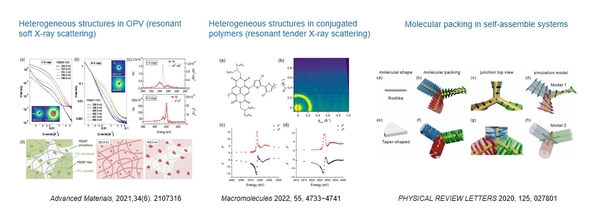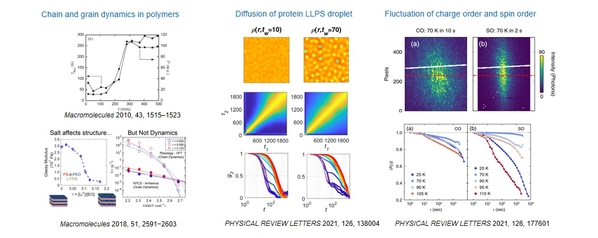- Mass Spectrometry for Energy Transformation and Astrochemistry
- Extreme Ultraviolet Electronic Structure Characterization and Lithography
- Electronic Structure Characterization for Operando Micro/Nano Devices
- High-sensitive, Space-Resolved and Time-Resolved Electron Spin Dynamics
- In-situ/Operando Soft X-ray Spectroscopy and Scattering
- Soft X-ray Ptychographic Nanoscopy
- Resonant Coherent Scattering
- High Throughput In-situ/Operando Tender X-ray Spectroscopy
- Tender X-ray Spectromicroscopy and Ptychography
- Test Beamline
Scope 1 (Resonant scattering)

Resonant scattering is a powerful technique to probe complex molecular structures, with the advantage of selective resonant enhancement for elements/chemical bonds and orientations. It is particularly suitable for studying heterogeneous molecular structures in functional polymers, self-assemble systems, nanoparticle-polymer mixtures, etc. BL07 provides multiple resonant edges (from Carbon to Calcium) and variable polarizations (linear and circular), providing even more possibilities for this widely-used technique.
Scope 2 (XPCS)

XPCS is an emerging technique to probe various forms of dynamics, such as diffusion and rotation of colloidal nanoparticles, dynamics of polymer segments, diffusion of biomacromolecules and their aggregates, fluctuation of superlattice structures in quantum materials, etc. The soft and tender X-ray regime of BL07 provide both high coherence and multiple resonant edges, such that heterogeneous dynamics inside the materials can be highlighted by performing XPCS at resonant energies.
Scope 3 (REXS)

The Resonant Elastic X-ray Scattering Station for Quantum Materials is key technique to investigate the superconducting mechanisms especially high-temperature superconductors—including copper-based, iron-based, and nickel-based systems—encompassing phenomena such as antiferromagnetic order, charge density waves, and orbital order. Unveiling microscopic superconducting mechanism of high-temperature superconductors is still a major scientific challenge in the field of condensed matter physics. Meanwhile, this technique can also be employed to investigate structures such as buried interfacial magnetism, domain wall chirality in topological ferromagnets and ferroelectric thin films. This technique is essential for the development, operational testing, and performance enhancement of next-generation spintronic devices.

